| About HINAMATSURI Below: Excerpts from Sushi and Sake Magagine | |||||||||||||
|
Hinamatsuri, Festival of Dolls Meiko Kodaira with Ed. Staff
Why is this day dedicated to the peach blossom? In Japan, the peach blossom is a symbol for happy marriage because of the way and the time the tree blooms. The time between the end of February and beginning of March is when winter turns to spring and is also the time when the peach tree blooms, changing people’s view from monotone to something colorful. Moreover, the blossoms represent the feminine traits of gentility, composure and tranquility.
This tradition was not specifically for girls at this point. However, it was becoming common that girls in high society would play with dolls. These dolls, called "hina," were made of paper, wood, clay, and other things they used in their everyday life. Time passed year after year, and eventually these two customs were mixed up. The practice of displaying these dolls on the third day of the third month on the traditional Japanese calendar began during the Edo Period (1603-1868).
A set of Hina dolls usually consists of at least 15 dolls which wear the costumes of a Heian Period Imperial court. The display also includes miniature household articles which are often exquisite artistic productions. The most highly valued dolls are the Dairi-sama, which represent the Emperor and Empress in resplendent court costumes of silk. They are attended by their two Ministers, three kanjo (Court Ladies), and five Court Musicians. All are displayed on one of usually five steps, each from 3 to 6 feet-long and covered with bright red cloth, making the figures look like they are sitting on a red carpet. The Imperial couple occupies the top step, the Emperor to the left of the Empress. The Court Ladies and banquet trays and dishes occupy the second tier, and the other dolls are arranged on the lower tiers.
These dolls are not played with but are ceremonial dolls, an heirloom of the household, many of them handed down from generation to generation. During festival time, they are displayed for a few days in the best room of the house, and, after March 3, they are carefully boxed and put away until the next year. Parents buy new sets of dolls for any girls born since the preceding festival, and relatives and friends make gifts of the dolls.
Whether the Hina doll set is a one-step type with only an Emperor and Princess or a 7-step type with extra servants and musicians, people display and celebrate the holiday the same. Most families have a doll set which been handed down from grandmother to mother, mother to daughter, and these dolls are brought as part of her bridal trousseau when she gets married.
There are some special foods that are eaten on Hinamatsuri day. A sweet snack only for Hinamatsuri is called Hina arare (grilled pieces of rice cake), and hishimochi (diamond shaped rice cakes with pink, green and white layers) are placed in front of the Hina dolls as an offering. A sweet drink called shirozake is made from fermented rice. It is kind of sake, but it doesn’t have alcohol, so it is okay for children to have. Besides all this, sushi is often offered.
Enjoying sweets, shirozake and sushi, the family sings the Hinamatsuri Song to celebrate the girls’ happiness. The song is really famous, and it seems like every Japanese person knows it. It depicts a happy Hinamatsuri.
After Hinamatsuri day, parents have to put the dolls away as soon as possible. It has to be done as soon as possible, because there is a tradition that says if they don't, their girl will not able to marry or will be late to marry. However, it's not just like cleaning your room. You have to treat them special care, put in moth repellent, and put in the appropriate boxes. Neglecting them will do the dolls harm, and you might not find them as nice the next year. Therefore, many families have to leave it until the weekend to get the job done. Even though Hinamatsuri is not a national holiday, it is still quite important for girls to celebrate. Almost all girls in Japan have Hina dolls, and it is a bit of concern what types (how many steps, how big, how it looks) the other girls have. Parents with little girls are very keen to celebrate this day. The meaning of Hinamatsuri is to celebrate girls' happiness, and the long history of Hinamatsuri makes us realize how much parents valued the daughters happiness. Grandmother to mother, mother to daughter, the wish for children’s happiness is forever.
|
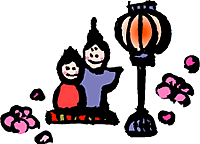 Hinamatsuri
takes place on March 3, and is the day that families pray for the
happiness and prosperity of their girls, helping to ensure that they
grow up healthy and beautiful. Families who have daughters display
special dolls for this festival and dedicate them to peach blossoms.
Hinamatsuri is also called Momo no Sekku meaning Peach Festival.
Hinamatsuri
takes place on March 3, and is the day that families pray for the
happiness and prosperity of their girls, helping to ensure that they
grow up healthy and beautiful. Families who have daughters display
special dolls for this festival and dedicate them to peach blossoms.
Hinamatsuri is also called Momo no Sekku meaning Peach Festival.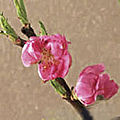 The
history of Hinamatsuri is very long. It is not known exactly when it
began, but it was mentioned in “The Tale of Genji,” a book written by
Murasaki Shikibu, and "Makura no Soushi" by Seishou Nagon in the Heian
Period (794-1192), about 1000 years ago. At that time, people prayed to
be healthy and to have fortune at the beginning of spring in March.
People asked psychics to pray and to offer up food for the Gods. These
psychics would remove evil spirits from the land and transfer these ill
fortunes and sickness to dolls. After that, the psychics throw the dolls
into the river or the sea.
The
history of Hinamatsuri is very long. It is not known exactly when it
began, but it was mentioned in “The Tale of Genji,” a book written by
Murasaki Shikibu, and "Makura no Soushi" by Seishou Nagon in the Heian
Period (794-1192), about 1000 years ago. At that time, people prayed to
be healthy and to have fortune at the beginning of spring in March.
People asked psychics to pray and to offer up food for the Gods. These
psychics would remove evil spirits from the land and transfer these ill
fortunes and sickness to dolls. After that, the psychics throw the dolls
into the river or the sea.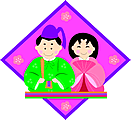
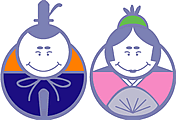
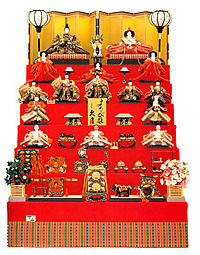 Sitting
at the top center are Emperor and Empress. They are wearing the
twelve-layered ceremonial robe called juhni-hitoe).
Sitting
at the top center are Emperor and Empress. They are wearing the
twelve-layered ceremonial robe called juhni-hitoe).
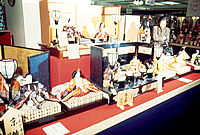 In
families with girls, parents start to display the Hina dolls about 2
weeks before the day of Hinamatsuri.
In
families with girls, parents start to display the Hina dolls about 2
weeks before the day of Hinamatsuri.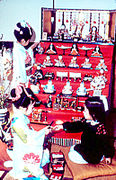
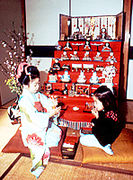
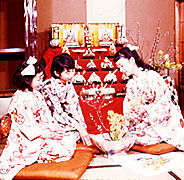
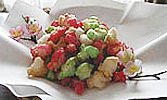
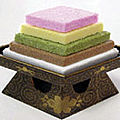
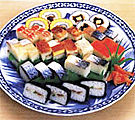
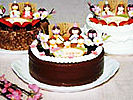
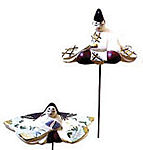 However,
the customs I have just explained is the old style of Hinamatsuri.
However,
the customs I have just explained is the old style of Hinamatsuri.